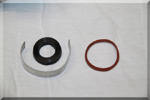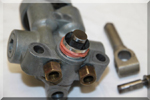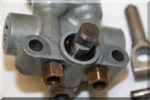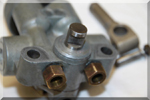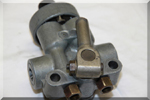Jackall Pump Actuator Shaft Seal Installation
By Richard Prior
Download this page as a PDF File here
The 18700562 seal is a modern lip seal not a donut seal, which is probably what was originally used in this location. There is a minor complication with this type of seal in this application that needs to be noted before installation. You cannot fit the seal into the pump body first then insert the shaft because the shaft will be pushing against the internal lip of the seal. If you do manage to force the shaft through then next the lip will snag on the cotter pin groove and surely be damaged.
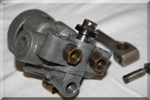 The best approach is first to insert the shaft and then the front cover plate to hold the shaft in place. Then with some lubrication on the shaft ease the seal, lip facing inwards of course, over the shaft. It is quite easy to get the lip over the shaft if you hold the seal at an angle to the shaft and rotate the seal around the shaft with just a little forward pressure. Then push the seal forward until it is in the cotter pin groove. The best approach is first to insert the shaft and then the front cover plate to hold the shaft in place. Then with some lubrication on the shaft ease the seal, lip facing inwards of course, over the shaft. It is quite easy to get the lip over the shaft if you hold the seal at an angle to the shaft and rotate the seal around the shaft with just a little forward pressure. Then push the seal forward until it is in the cotter pin groove.
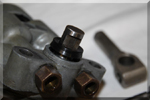 A frequent question was about the set up of the Smith's Jackall system, integral to the Y types, usually triggered by spotting a device of unknown function under the bonnet (the distribution unit [more commonly called the Jackall pump]). As I had observed leakage of the hydraulic fluid from my system (or more correctly, my car's system) some months earlier, I had drained the reservoir and tried to locate the source of the leak. Cleaning and re-tightening the olive on the feed to the distribution unit had not remedied things, and I had reluctantly come to the conclusion that the inner seals were at fault. As a result, I was able to describe the system, but unable to put on the usual handle pumping demonstration for the interested partiesWith the seal in the cotter pin groove rotate the pump and or shaft so that the groove is uppermost and in full view and very carefully slide the seal forward again at an angle to the shaft. When the seal lip reaches a corner of the groove (either left or right depending on which way the seal is angled) carefully with a small screwdriver ease the seal lip over the inner edge of the cotter pin groove, keep the screwdriver in place and the lip protected from the sharp edge and slowly rotate the seal and screwdriver in unison (keeping it angled) until the lip is all the way over the shaft on the other side of the groove. The seal can then be slid forward to the pump body. A frequent question was about the set up of the Smith's Jackall system, integral to the Y types, usually triggered by spotting a device of unknown function under the bonnet (the distribution unit [more commonly called the Jackall pump]). As I had observed leakage of the hydraulic fluid from my system (or more correctly, my car's system) some months earlier, I had drained the reservoir and tried to locate the source of the leak. Cleaning and re-tightening the olive on the feed to the distribution unit had not remedied things, and I had reluctantly come to the conclusion that the inner seals were at fault. As a result, I was able to describe the system, but unable to put on the usual handle pumping demonstration for the interested partiesWith the seal in the cotter pin groove rotate the pump and or shaft so that the groove is uppermost and in full view and very carefully slide the seal forward again at an angle to the shaft. When the seal lip reaches a corner of the groove (either left or right depending on which way the seal is angled) carefully with a small screwdriver ease the seal lip over the inner edge of the cotter pin groove, keep the screwdriver in place and the lip protected from the sharp edge and slowly rotate the seal and screwdriver in unison (keeping it angled) until the lip is all the way over the shaft on the other side of the groove. The seal can then be slid forward to the pump body.
Because the outer lip of the seal is obviously larger than the ID of the pump body it does require some patience to gradually and carefully work around the seal with your thumbnail to get the seal into the housing.. A little trick here to avoid frustration is to cut a strip of tinplate out of a tin can about 12mm (0.5") wide and a little longer than the circumference of the seal 85mm (3.25"). Check all the edges of the tinplate to make sure they are smooth and not likely to cut the seal. Close the strip around the seal just enough to compress the lip. Place a rubber band around the tinplate and seal to keep it in compression but not too strong so as to distort the shape of the seal. Line it up over the housing and evenly push the seal into the cavity with small piece of flat ended rod or dowel (not a screwdriver) just like using a piston ring compressor!!!
Fit the dust cover and the lever spigot together with its cotter pin. Make sure the cotter pin is firmly in place and the nut is tight. Note the cotter pin only goes into it's hole one way because it is tapered! Job done!!!
Note: Any opinions expressed are solely those of the author and do not necessarily reflect those of the International MG Y Type Register.
Disclaimer
Please Note read our disclaimer before attempting any mechanical or other modifications or methods referred to herein. | 



